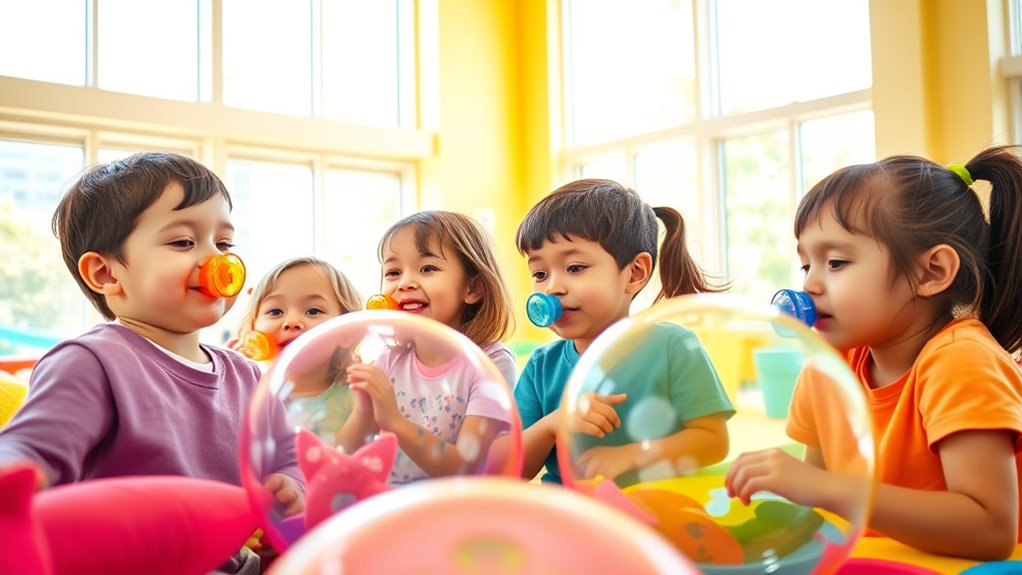Looking for breathing games kids enjoy? You can play fun activities like pretending to blow up a balloon with slow, deep breaths or imagining blowing dandelion seeds or floating feathers. Games like “breathe like a dragon” with roaring exhalations or exploring imaginary worlds where children gather strength and release tension keep kids engaged while learning to relax. Keep exploring for more creative ideas to make relaxation both simple and exciting for your little one.
Key Takeaways
- Fun activities like blowing up a balloon or floating feathers turn breathing into playful, engaging games for kids.
- Using imaginative themes such as dragons or explorers makes breathing exercises exciting and memorable.
- Incorporating visual cues like pictures or animated characters helps children stay focused during breathing games.
- Story-based breathing adventures encourage kids to practice relaxation while exploring imaginary worlds.
- Combining breathing with physical movements or pretend play keeps children interested and motivated to participate regularly.

Have you ever wondered how simple breathing exercises can make a big difference for kids? It’s true—teaching children to focus on their breath can help them manage stress, feel calmer, and improve their overall well-being. One effective way to introduce this is through fun breathing games that incorporate mindful breathing and relaxation techniques. These activities turn what might seem like quiet, serious exercises into engaging, playful experiences that kids genuinely enjoy.
When you start with mindful breathing, you encourage kids to pay close attention to their breath, noticing how it feels as they inhale and exhale. This simple act of awareness can ground them in the present moment, helping to reduce anxiety and promote emotional regulation. Incorporating relaxation techniques into breathing games makes the process even more accessible. For example, you might have children pretend they are blowing up a balloon, taking slow, deep breaths to fill it up, then slowly releasing the air with a gentle exhale. This playful approach not only makes the exercise fun but also teaches kids how to control their breathing and relax their bodies.
Start with mindful breathing to help kids stay present, reduce anxiety, and learn to relax their bodies through playful exercises.
Another popular game involves using visual cues, like imagining they are blowing on a dandelion or a feather. Kids take deep breaths to blow the dandelion seeds or keep the feather floating, focusing on steady, controlled exhalations. These activities help children develop mindful breathing habits without feeling pressured. You can also turn breathing into a game of “breathe like a dragon,” where kids take deep, fiery breaths and then exhale with a roaring sound, adding a sense of imagination and excitement. Such games make relaxation techniques feel less like a chore and more like an adventure, encouraging kids to practice regularly.
Incorporating storytelling can make mindful breathing even more appealing. For example, you might create a story where children are explorers discovering calmness inside their bodies. They breathe in to gather strength and breathe out to release tension as they navigate imaginary worlds. Trying different breathing exercises can introduce variety and keep children engaged, making the practice more effective and enjoyable. These stories deepen their focus on their breath and reinforce relaxation techniques in a fun, immersive way.
Frequently Asked Questions
Are Breathing Games Suitable for Children With Asthma?
Breathing games can be suitable for children with asthma if used carefully, as they promote asthma management and improve breathing techniques. However, you should consult your child’s healthcare provider before starting any new activities. These games can help children learn controlled breathing, but always monitor their responses and stop if they experience discomfort. Proper guidance guarantees they benefit from the exercises without risking asthma symptoms.
How Often Should Kids Play Breathing Games for Best Results?
You might wonder how often kids should play breathing games to see real benefits. Generally, practicing mindfulness techniques and relaxation methods daily, around 10-15 minutes, can make a difference. But the key is consistency—skip too many days, and progress slows. Keep it engaging, and your child will look forward to these sessions, revealing better breath control and calmer moments. Ready to see the positive change?
Can Breathing Games Help Improve Children’s Focus and Concentration?
Yes, breathing games can help improve your child’s focus and concentration. By incorporating mindfulness techniques, these games teach kids to stay present and manage stress reduction effectively. As they practice regularly, children develop better attention spans and emotional regulation, making it easier for them to concentrate on tasks. You’ll notice increased calmness and improved cognitive skills, all while having fun and learning valuable relaxation techniques.
Are There Any Risks Associated With Breathing Exercises for Kids?
There are some safety concerns and developmental considerations you should keep in mind with breathing exercises for kids. While generally safe, improper technique or forcing breath control can cause dizziness or discomfort. It’s important to supervise children and tailor exercises to their age and developmental stage. Always encourage gentle, relaxed breathing, and stop if they experience any pain or discomfort. Consulting a healthcare professional can make sure exercises are safe for your child’s specific needs.
Do Breathing Games Require Special Equipment or Apps?
Did you know that 85% of kids find breathing techniques more engaging through interactive game design? Breathing games usually don’t require special equipment or apps, making them accessible and simple to incorporate into daily routines. You can use everyday items or just your own body for game design, encouraging kids to practice breathing exercises while having fun. This approach helps develop mindfulness without needing extra tools.
Conclusion
Now that you know these fun breathing games, you can help kids stay calm and focused while having a blast. Remember, just like the Wright brothers dreamed of flying, encouraging mindful breathing can lift their spirits and build resilience. So, keep these games in your toolkit, and watch your children soar through challenges with a calm mind and a joyful heart. After all, the future belongs to those who breathe easy and dream big.










